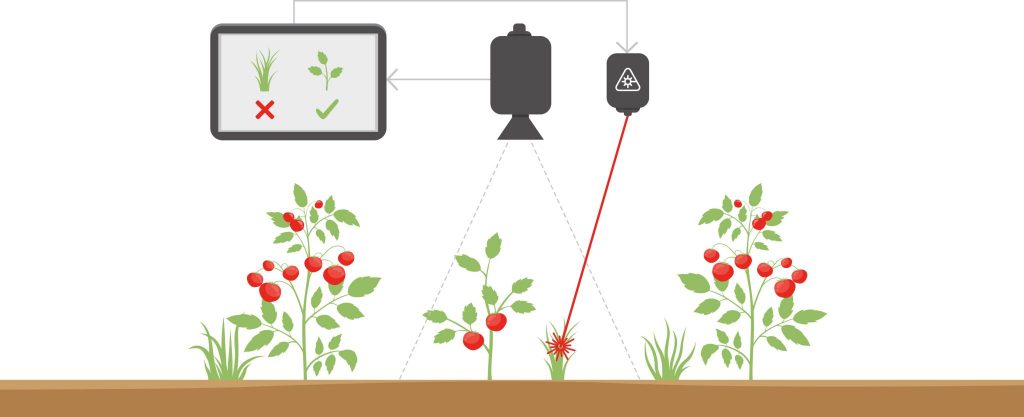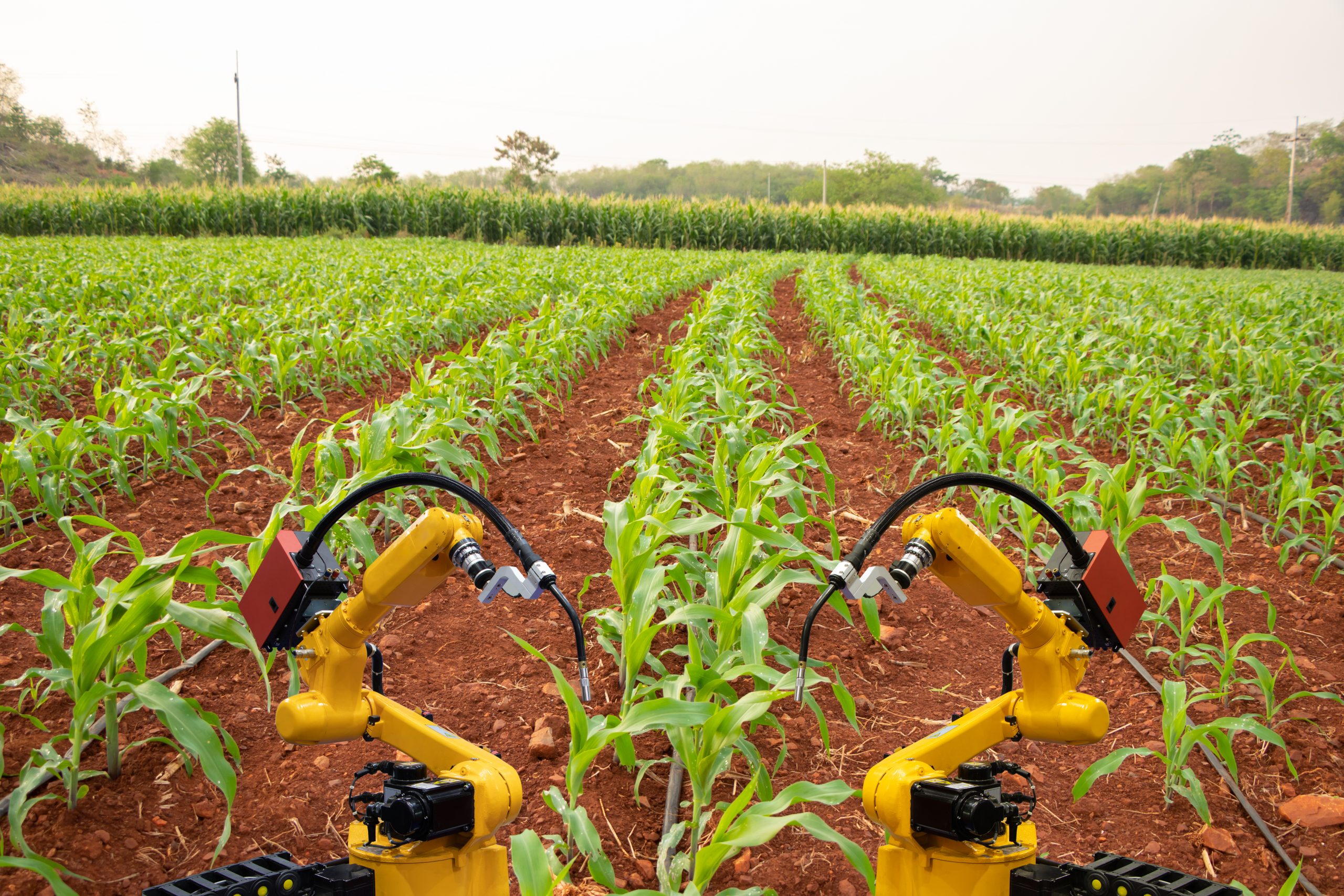Laser weeding (LW) as a promising alternative to chemical-synthetic approaches to weed control contains a high potential for the future. Learn how this technology works and why it contributes to more sustainable agriculture.
Introduction
In recent times, the agricultural industry has undergone remarkable advancements to enhance efficiency and sustainability. One remarkable innovation that deserves our attention is laser weeding. It is a revolutionary technique that harnesses the power of lasers to selectively eliminate weeds. Despite conventional practices, it does not require harmful herbicides or excessive manual labour. In this article, we will delve into the workings of LW and explore its potential benefits for modern agriculture.
Laser weeding involves the use of high-energy lasers to target and destroy unwanted weeds. Its technology, however, originates from laser-cutting techniques employed in industrial processes. Through precision targeting, the laser thus heats and vaporizes the cells of the plants, effectively killing them. Since it is controlled by sophisticated algorithms and sensors, the lasers can differentiate between crops and weeds. This therefore ensures the protection of valuable agricultural produce.

Source: Escarda Technologies
Benefits of Laser Weeding
- Environmentally Friendly: Unlike traditional herbicides, LW eliminates the need for chemical agents. Hence, it is a safe and eco-friendly method of weed control. It minimizes the release of toxic substances into the environment, reducing harm to other beneficial plant species, insects, and animals.
- Cost-effective and Resource-efficient: It has the potential to cut costs associated with manual labor or the application of herbicides. With advancements in technology, LW systems become more affordable, and their application can result in long-term savings for farmers. Additionally, since LW targets only weeds, it helps save water and fertilizer resources while maximizing crop yield.
- Precision and Non-contact Operation: LW ensures precise targeting of individual weeds, without causing any damage to the crop or soil. This eliminates the risk of accidental crop loss or soil degradation caused by traditional weeding methods. Furthermore, farmers can mount lasers on robotic platforms and operate them remotely, reducing physical strain and enhancing efficiency.
Risks Associated with Laser Weeding
Though laser weeding holds immense promise, there are challenges to overcome. Laser systems must be suitably adapted for various soil and crop conditions, and their energy requirements must be optimized to make them widely accessible to farmers. Additionally, further research and development efforts are needed to enhance automation and eliminate any limitations regarding weed detection accuracy and speed.
Looking ahead, LW presents a futuristic approach to weed management in agriculture. By combining it with other emerging technologies, such as artificial intelligence and precision agriculture, we can expect even greater advancements in this field. With continued focus on innovation, LW has the potential to transform modern agriculture into a more sustainable, efficient, and environmentally friendly industry.
Main Startups in the Field
Escarda Technologies is a German venture company developing an AI-based robotic LW solution. Their technology consists of software that detects and classifies weeds in cropland with high-speed image acquisition, targeting and eradicating them with a precise laser. In addition, they use machine learning to collect data. Carbon Robotics is a well-known Startup based in the US. This company is also developing an AI-based robotic LW system. The system is powered by Nvidia GPUs. It identifies weed with a 42 high-resolution camera and can generate deep-learning-based computer vision models. Thus, it is ready to fire 30x 150 W CO2 lasers with millimeter accuracy every 50 milliseconds.

Explore all Key Player:
Example Case Study
WeLASER is a 3-year EU-funded project which dedicated itself to the development of an AI-autonomous smart robot equipped with laser vision to kill weeds with high precision. This technology has a huge potential because it makes agriculture independent of chemical herbicides. The weed-killing laser is really powerful, and the project is coordinated by researchers from the Netherlands, Belgium, Spain, France, Germany, Poland and Italy. This team analyzed the efficiency by the robot and came to the result that the robot detects at least 90 % of weeds and meristems and has an accuracy of 1.5 mm in area. The program has a budget of €5.4 million and focuses on converting the so far diesel-powered prototype to a 100 % electric robot.
Takeaway
Laser weeding represents a game-changer in weed control, providing a safe, cost-effective, and resource-efficient alternative to traditional methods. As we navigate the challenges of feeding an ever-growing global population while preserving our natural resources, LW offers hope for a more sustainable and productive future in agriculture. Embracing this technology will pave the way for a revolution in weed management, hence improving the livelihoods of farmers and contributing to a greener planet.
Explore related topics
- Agriculture & Forestry Posts
- Aquaculture Posts
- Bio-based Product Posts
- Bio-Resource Conversion Industry Posts
- Blog
- CO2 & Waste Utilization Posts
- Food & Beverage Posts
- Water & Renewable Energy Posts
Sources:
- https://innovationorigins.com/en/killing-weeds-in-a-sustainable-way-using-a-autonomous-robot-with-laser-vision/
- https://www.escarda.tech/technology/
- https://geneticliteracyproject.org/2018/06/18/laser-weeding-can-robots-partially-replace-farm-tractors-harvesters-and-even-herbicides-like-glyphosate/
- https://forum.farmbot.org/t/farmbot-laser-weeder-tool-demonstration-proof-of-concept-project-cyclops/7545
- http://theanoholic.sakura.ne.jp/makinohara/2018/11/17/robotic-laser-weeding-prospective-technologies-for-organic-tea-farming-1/
- https://carbonrobotics.com/


